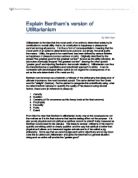Explain the difference between Bentham and Mills forms of utilitarianism
Explain the difference between Bentham and Mill’s forms of utilitarianism
Bentham started the theory of utilitarianism. He based his theory on pain and pleasure. He used hedonism- the maximising of pleasure and the minimising of pain, and the principle of utility- the greatest pleasure for the greatest number. In order to judge actions he came up with the hedonic calculus. Mill developed his theory but instead, he focused on happiness for everyone, each individual. Mill also believed in higher and lower pleasures. Bentham is usually associated with Act utilitarianism, Mill is associated with Rule utilitarianism.
Bentham’s belief that an action is right if the number of people who benefited was higher than those who didn’t was what Mill criticised. Mill was concerned with the ‘sadistic guards’ problem where two or more guards getting pleasure from attacking a prisoner obviously wouldn’t be right. He thought that a sadist’s pleasure is bodily and low so it does not outweigh the prisoner’s pain. Mill and Bentham believed different things about utility. Bentham prioritised the number of individuals and the amount of pleasure. Whereas Mill prioritised each individual and the quality of the pleasure.









